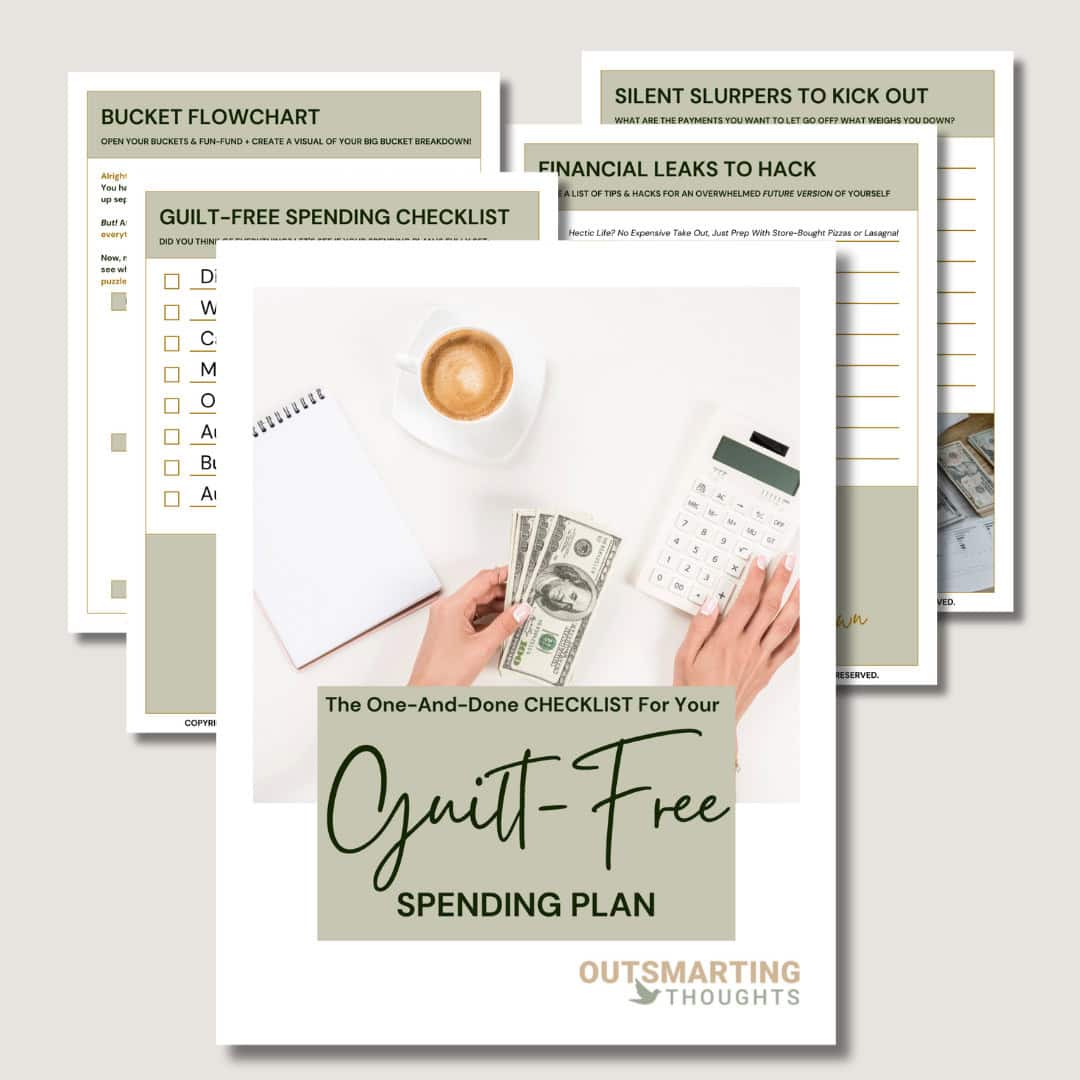Wanna know how to stop spending money on food when you’re tired, stressed, and out of bandwidth? This post is dedicated to helping you stop the emotional and chaotic food spending spiral by giving you concrete levels of strategy that match your actual wallet, not some ideal version of yourself.
Food is one of the most socially accepted ways to self-soothe, and it’s even marketed as self-care. Unfortunately, it often becomes a silent money leak. Overspending on food doesn’t just happen when you’re hungry. It happens when you’re emotionally spent, stressed out, mentally depleted, or simply too burned out to plan ahead.
What you’re going to learn is is how to stop spending money on food based on your current season of life. You’ll get a clear map for how to shift between extreme frugal triage and indulgent structure without shame, and how to stop using food as your only pressure valve. We’ll give you the mindset and tools to make your budget feel like a support system, not a punishment.
After you have learned to pair food decisions with your actual needs, you’ll be able to eat better, feel calmer, and keep your money where it belongs: supporting you, your values, and your goals.
This post is all about how to stop spending money on food so you can feed your future, not your stress-levels.
How To Stop Spending Money On Food
Overspending on food is about way more than just laziness or indulgence. When you peel back the layers, it’s often a direct result of emotional burnout, mental exhaustion, and a complete lack of structure. Food is one of the easiest legal ways to self-soother, reward yourself, or numb out the stress. Especially when you’re overwhelmed, under-supported, and just trying to keep up with life.
Buying groceries without a plan? Rewarding yourself with takeout after a rough day? Overspending on food usually isn’t random. The psychology behind overspending, is that it’s a coping mechanism for overwhelm. And that’s not a judgment. It’s a reality check: it’s not YOU, it’s your environment. You’re not a mess. You’re surviving in a system that makes it almost impossible to even stay regulated.
So let’s break down 4 levels of how to stop spending money on food. Because if you want to get a grip, you need to be flexible and adaptable according to your current financial situation. These levels are strategic interventions. You can move between them as your budget, energy, and bandwidth shift. This is NOT about eating clean & perfect, or good nutrition. It’s about finding a structure that works for your life & wallet. Let’s help you pick a level that fits your season, not your shame.
Level #1: The Hiker Hobo
Sometimes your finances hit a wall, and your grocery habits have to go into real survival mode. That’s where the Hiker Hobo level comes in. You’re not here for pleasure, you’re here to patch the financial holes in your budget. That means eating crap like a hiker: rice, ramen noodles, frozen veggies, canned beans, eggs, oats. Repetitive? Yes. Glamorous? Absolutely not. But when rent is due AND the car needs a $1000 repair, this is a level to temporarily opt in to, to stay upright without breaking the bank.
This level is hardcore, but possible and essential when you need to triage your money fast. You’re shavin’ every possible cent off your monthly food expenses to gain traction elsewhere. It’s biting the bullet for long-term gains. And guess what? That’s a power move. You’re not being irresponsible, you’re sacrificing and showing up for your future self in a crisis.
RELATED POST:
Intentional Spending: The CEO-Mindset And AntiDote Against Overspending & Impulse Buying
If this feels extreme, that’s because it is. But it’s also incredibly effective. You’re removing all friction. You eat what you planned, and what’s cheap. Yes, that does mean that at this level you eat a lot of crap. But it’s a strategy to chase financial relief instead.
Don’t ever shame yourself for being here. Some months are harder than others. The key is seeing this not as a punishment, but as a form of resourceful resilience. You’re stabilizing your money so you can build back up from solid ground. That’s not failure. That’s a strategic investment.
Level #2: The Practical Prepper
If you’re ready to stop eating like crap, but still need to keep your grocery budget low, welcome to Level 2. This is where you turn food into a system. The Practical Prepper meal preps like a pro, shops just once a week, and sticks to the plan.
Your core strategy here is all about preparation. You batch-cook three of four big meals and rotate them like a playlist. You check your pantry before shopping. It’s all about only buying what you need, using what you have, and wasting nothing. Maybe you experiment with cutting out meat for a week or month, or just add it on Sundays. You keep snacks simple and prep-friendly. The name of the game is staying ahead.
You’re still spending very little, but the emotional and nutritional quality goes way up. When you have to take care of a family, this is probably the lowest level you can go. This level is great when your life is full, your brain is overloaded, but you still want to respect your money. It reduces decision fatigue, prevents emotional takeout binges, and creates a routine you can lean on. If you need to be frugal, you can always add ‘hiker hobo days’, where it’s just frozen pizza day.
You’re not striving for perfect meals, You’re striving for fewer breakdowns at 06:45PM when you realize you forgot to eat, and order last-minute takeout. This is the perspective & lifestyle where food is fuel. It’s still minimalist, but it’s smarter. More sustainable. More in control.
Owning a cashflow strategy is a skill that’ll give you some serious advantages in life. I think budgeting is an aligned action with taking life seriously, and I seriously believe life will reward you for it. If you’re not into high-maintenance strategies like ‘tracking your spending’ and just want to sit down ONCE to direct your financial future, our Guilt-Free Spending Plan Printable is the right cashflow strategy for you! Don’t let anybody outsmart you out of your own money and start budgeting today by simply filling out the form below:

Want a free
ONE-AND-DONE CHECKLIST for aGUILT-FREE SPENDING PLAN? Free up your bandwidth and stop overthinking with this
FREE One-And-Done Checklist for your Guilt-Free Spending Plan!
Simply fill out the form below to get this strategy
delivered straight to your inbox!
Level #3: The Mindful Minimalist
At level 3, you’re not just trying to save money, you’re learning to spend it with clarity. You’re still prepping and managing your meals, but now, there’s room for small, intentional indulgences that don’t wreck your budget or your mood.
This level is about recognizing the emotional patterns that drive your food decisions. You notice when the stress hits, and instead of numbing out with snacks, you pause and check in with yourself. You’ve learned that food can bring happiness, but only if it doesn’t lead to depressed states afterward.
RELATED POST:
The Overspending And Depression Hell-Loop: Find Out The Missing Link Between Feel-Good Purchases And Inner Emptiness
This is where you reward yourself without derailing your progress. The self-reward stays proportioned to your finances! Maybe you grab a bottle of wine and a small cheese board for Friday night. That $15 isn’t a mindless splurge, it’s a conscious trade for grounded comfort. The money still fits in the plan, and the reward feels earned, not impulsive.
You’re no longer trapped in reactive spending, or having to scrape by like in levels 1 & 2. Instead, you’re using your food budget as a tool to regulate before you unravel. You’re still honoring your values & goals, but you’re also honoring your cravings with wisdom and proportioned self-control.
This level teaches you to balance discipline with delight & desire. You no longer binge because you’ve impulsively decided that you ‘deserve it’. You invest in moments that keep your nervous system steady. And when you get this balance right? You’re not just managing your food spending. You’re mastering your emotional ecosystem.
Level #4: The Conscious Foodie
When you reach Level 4, you’re no longer fighting your food budget anymore. You’re flowing with it. You’ve built the structure, practiced the discipline, and now you get to enjoy the freedom it creates. This is where planning meets pleasure in a way that feels natural, not forced.
You plan your indulgences like a strategist. Maybe it’s dinner out with friends. Or maybe it’s high-quality ingredients that make your week feel luxurious. The difference is that you’ve already accounted for it.
This level is about alignment and intention. Your spending now supports the life you actually want, not the life you’re trying to escape. You’ve let go of fearing food as a budget break. Instead, you’ve made food a ritual that matches your bandwidth, your priorities, and your goals.
When life throws you a curveball? You can always shift back levels without shame. Because you’ve learned that managing food isn’t a fixed-line. It’s a cycle that adapts as your seasons shift. You lead with strategy, not guilt or shame. And you bounce back with grace, not with judgment or regret.
Ultimately, you’re not spending on food anymore. You’re investing in a lifestyle that brings stability, pride, and actual happiness. That’s what financial maturity looks like. And that’s how you keep designing a life you don’t want to run away from.
How To Stop Spending Money On Food (Summary)
Overspending on food doesn’t mean you’re reckless, it means you’ve been coping with stress in the only way you knew how to. Food became the coping tool. But now, you’re ready to replace it with something stronger.
These four levels aren’t a diet plan or a moral ladder. They’re strategic tools to help you align your money with your bandwidth. Some months will call for bare-bones budgeting. Other will let you savor and indulge. You can switch between levels without shame, because flexibility is what keeps you strong & stable.
Once you stop reacting and start planning, your entire experience with food shifts. You spend with purpose, not panic. You eat with intention, not impulse. And most importantly, you trust yourself more each week.
You don’t need to ‘fix yourself’. You only need a structure that honors your real life & situation. So pick you level accordingly, adapt when needed, and lead your life with clarity. You’re not failing, you’re learning and evolving into your most powerful, resourceful self.
This post was all about how to stop spending money on food so you can feed your future, not your stress-levels.
We aim to help you out as much as possible, but please keep in mind that the content is only for general informational and educational purposes. We offer our services based on independent research and life-experience only, and so our strategies can never serve as a substitute for professional advice. Trust me, we do not have 'everything figured out', are all still huge works in progress, but hey, what works for us, might work for you too! This is allll up for you to decide... It might not work for you, and that's okay, so cherrypick the stuff that resonates and leave the stuff that doesn't, and let's go!








